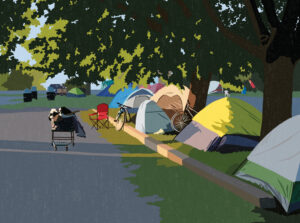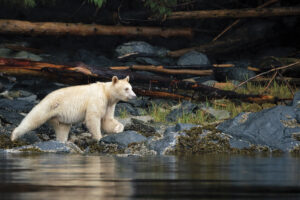
People & Culture
Kahkiihtwaam ee-pee-kiiweehtataahk: Bringing it back home again
The story of how a critically endangered Indigenous language can be saved
- 6310 words
- 26 minutes
This article is over 5 years old and may contain outdated information.
People & Culture

Few can say they’ve seen a dinosaur skeleton outside of a museum. Fewer still can say their eyes were the first in about 100 million years to gaze upon the bones in the dirt.
“When you find a fossil and you recognize it, you get really excited,” says world-renowned Canadian paleontologist Philip Currie (above). “It’s just like being a kid again. You can’t really be blasé about it in any way.”
For Currie, who served as one of the inspirations for Jurassic Park’s Alan Grant character, the excitement of unearthing a new dinosaur skeleton has kept his nose in the sandstone for more than three decades. In May, he will share his paleontological experiences at the Royal Canadian Geographical Society’s (RCGS) Speaker Series.
Currie is at the forefront of dinosaur discovery, having named 25 new dinosaur species and their reptilian predecessors since graduating with a masters of science from McGill University in 1975.
Fresh out of school, Currie landed a position as curator of paleontology at the Provincial Museum of Alberta (now the Royal Alberta Museum), a testament to the potential that was evident in a young man still without his Ph.D.
That position launched his career, putting him in Alberta’s Dinosaur Provincial Park, one of the richest sources of dinosaur fossils on Earth and a “fantastic playground for paleontologists.”
In the 1980s, the museum was bursting with the fossils Currie and his team were uncovering, leading to the creation of the Royal Tyrrell Museum of Palaeontology, located just outside of Drumheller, Alta., where Currie became head of dinosaur research.
Currie’s work led to his groundbreaking theory that large carnivorous dinosaurs, such as the fierce albertosaurus and gorgosaurus — T. rex’s ancestors — were, in fact, intelligent enough to hunt in packs. This hypothesis has been featured in numerous books and documentaries, including the Discovery Channel’s “Dino Gangs.”
Now Currie is a professor at the University of Alberta and holds the Canada Research Chair in Dinosaur Paleobiology. His work has earned him recognition in the scientific community and has taken him to just about every continent.
In the exotic and varied climate of Mongolia, which Currie has visited annually since 1999, the paleontologist has discovered skeletons of small dinosaurs — more complete versions of the kind found in Alberta.
Currie says one of his favourite expeditions was in Antarctica. Almost 20 years of chipping away at permafrost and dense rock revealed the skeleton of a creature with a crest resembling a snow shovel on the top of its head. Called a cryolophosaurus, it is the only known specimen in the world.
Currie, a Fellow of the RCGS since 2009, will delve into the world of dinosaur behaviour in his presentation on May 2 at the Canadian Museum of Civilization Theatre in Gatineau, Que.
Are you passionate about Canadian geography?
You can support Canadian Geographic in 3 ways:

People & Culture
The story of how a critically endangered Indigenous language can be saved

People & Culture
Indigenous knowledge allowed ecosystems to thrive for millennia — and now it’s finally being recognized as integral in solving the world’s biodiversity crisis. What part did it play in COP15?

People & Culture
For unhoused residents and those who help them, the pandemic was another wave in a rising tide of challenges

Wildlife
How ‘maas ol, the spirit bear, connects us to the last glacial maximum of the Pacific Northwest